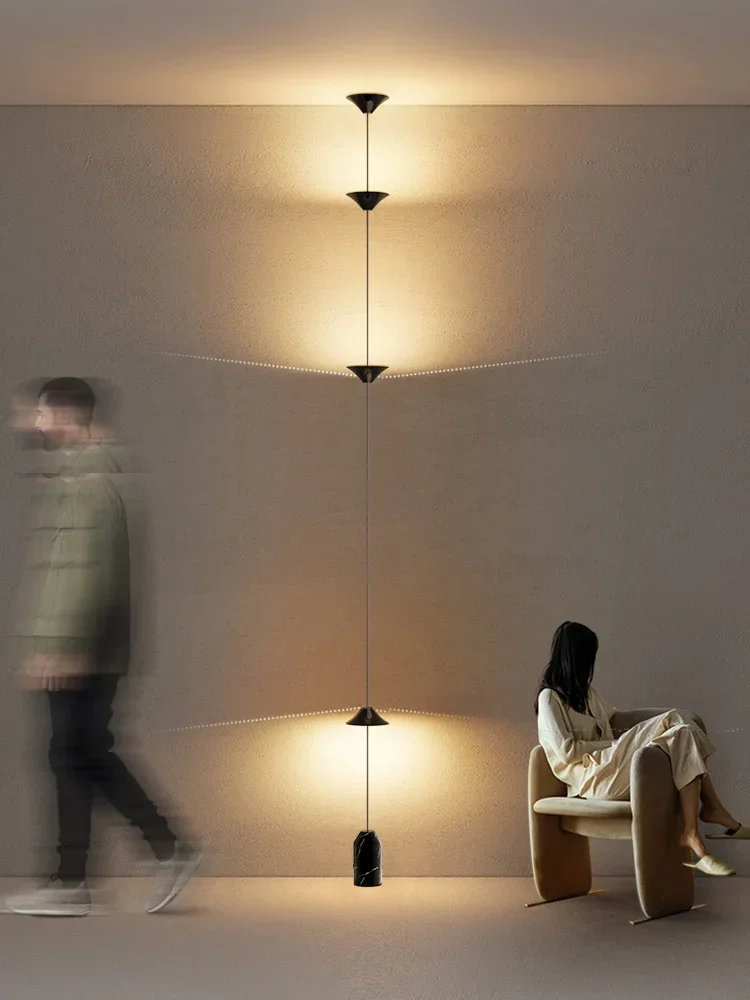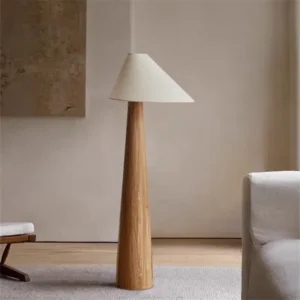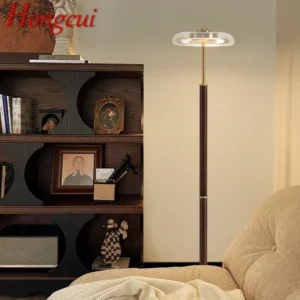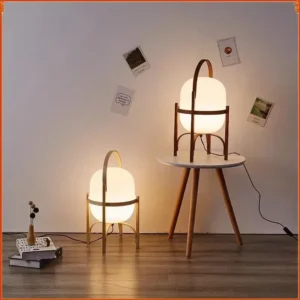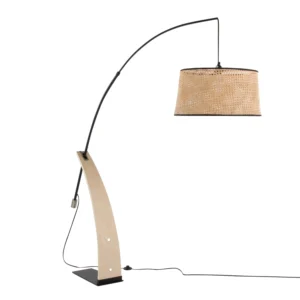Introduction: The Timeless Allure of Wood-Toned Arc Floor Lamps
Wood has remained a beloved material in lighting design for generations, bringing warmth and natural beauty to functional pieces that illuminate our homes. Arc floor lamps with wooden elements combine the striking silhouette of a curved lighting fixture with the organic appeal of wood, creating pieces that are both artful and practical.
Selecting the right wood tone for your arc floor lamp isn’t simply about matching furniture—it’s about creating balance and harmony within your space. The perfect wood tone can enhance your existing decor, serve as a stunning focal point, or subtly complement your overall design aesthetic. With various options ranging from pale ash to rich mahogany, the choice significantly impacts how the lamp interacts with your space.
In today’s homes, lighting serves dual purposes: practical illumination and aesthetic enhancement. A thoughtfully chosen wood-toned arc lamp accomplishes both, providing directed light while contributing to your room’s style narrative. Understanding the fundamentals of choosing perfect arc floor lamps helps create spaces that feel intentionally designed and personally meaningful.
This guide will walk you through everything you need to know about wood tones for arc floor lamps—from understanding basic wood tone principles to specific recommendations for various interior styles—ensuring you make an informed and stylish choice for your home.
Understanding Wood Tone Fundamentals for Arc Lamps
Before diving into specific recommendations, it’s important to understand the basics of wood tones and how they function in home design. Wood tones in arc floor lamps aren’t just about color—they involve undertones, grain patterns, and how these elements interact with light and space.
Modern arc floor lamps offer a spectrum of wood tones ranging from very light (blonde woods like ash or maple) to extremely dark (ebony or espresso finishes). Between these extremes lie countless variations of medium woods like oak, walnut, and cherry. Each tone creates a different visual impact and emotional response in a space.
The size of your room greatly influences which wood tone will work best. Larger rooms can accommodate darker, more substantial wood tones that might overwhelm smaller spaces. Similarly, rooms with abundant natural light interact differently with wood tones than dimmer spaces where the lamp itself provides significant illumination.
Understanding how light interacts with wood is crucial when selecting an arc lamp. Natural wood absorbs and reflects light differently based on its color, grain pattern, and finish. Lighter woods generally reflect more light, making spaces feel airier and more open, while darker woods absorb more light, creating a sense of groundedness and sophistication.
The comprehensive arc floor lamp guide can help you understand how various styles work in different settings, but let’s explore how wood tones specifically contribute to your lamp’s visual impact.
Warm vs. Cool Wood Tones: Creating Atmosphere
Wood tones can be broadly categorized as either warm or cool, each creating distinctly different atmospheres in your space:
Warm Wood Tones:
* Feature yellow, red, or orange undertones (cherry, mahogany, hickory)
* Create cozy, inviting, and energetic environments
* Complement warm color schemes with reds, oranges, and earthy tones
* Tend to feel more traditional or classic in appearance
* Enhance spaces meant for socializing and comfort
Cool Wood Tones:
* Feature gray, blue, or ashy undertones (certain maples, gray-washed oak)
* Create calm, sophisticated, and contemporary environments
* Complement cool color schemes with blues, greens, and crisp whites
* Generally feel more modern or Scandinavian in style
* Enhance spaces meant for relaxation and tranquility
The undertones in wood significantly impact how they interact with your existing decor. For instance, a walnut with red undertones will harmonize with warm-toned fabrics, while a walnut with cooler brown undertones will better complement blues and grays.
Lighting dramatically affects how we perceive wood tones. Under warm lighting (like incandescent bulbs), wood appears warmer and richer. Under cooler lighting (like some LEDs), the same wood might appear more subdued or gray. When selecting a wood arc floor lamp, consider both the wood’s natural tone and how your home’s lighting will interact with it.
Light vs. Dark Wood Tones: Space Perception
Beyond warm and cool classifications, the lightness or darkness of wood tones significantly affects spatial perception:
Light Wood Tones:
* Create an airy, open feeling that visually expands space
* Reflect more light throughout the room
* Appear less visually weighty or imposing
* Work exceptionally well in smaller rooms or spaces with limited natural light
* Include blonde woods like ash, maple, birch, and light oak
Dark Wood Tones:
* Create drama, definition, and sophisticated focal points
* Absorb more light, creating contrast and depth
* Appear more substantial and grounding in a space
* Work best in larger rooms or spaces where visual weight is desired
* Include deeper woods like walnut, espresso finishes, ebony, and mahogany
The relationship between room size and wood tone is important but not absolute. While small rooms generally benefit from lighter tones that won’t overwhelm the space, a dark wood lamp can create an intentional focal point in a small room when used strategically.
The shade design of your modern arc floor lamp also interacts with your chosen wood tone. A transparent or light-colored shade allows more appreciation of the wood base, while a dark, opaque shade creates stronger contrast with lighter woods and blends more with darker woods.
Popular Wood Tones for Arc Floor Lamps
The market offers numerous wood tone options for arc floor lamps, ranging from natural solid woods to engineered woods with specialized finishes. Manufacturers typically categorize these into light, medium, dark, and specialty finishes, though there’s considerable variation within each category.
When evaluating wood tones, understand that natural woods will have inherent variation in grain, color, and character, while engineered woods (like MDF with wood veneer) offer more consistency. Both have their place in quality lamps, with natural woods typically commanding higher prices for their unique beauty and authenticity.
The manufacturing process significantly impacts the final appearance of wood tones. Techniques like staining, fuming, and hand-rubbing can dramatically alter the wood’s natural color, while different sealants affect the sheen level from matte to high-gloss.
Let’s explore the most popular wood tone categories found in quality mid-century vintage arc floor lamps and contemporary designs.
Light Wood Tones: Bright and Airy Aesthetics
Light wood tones create a fresh, contemporary feel that’s particularly popular in modern design. These woods bring brightness and a sense of nature-inspired minimalism to your space.
Common Light Wood Options:
* Light Oak: Featuring visible grain and a warm honey-blonde color
* Ash: Pale with straight grain patterns and excellent light reflection
* Birch: Smooth with subtle grain and a pale yellow undertone
* Whitewashed/Bleached Woods: Treated to appear even lighter with a coastal vibe
Light wood arc lamps excel in creating a subtle presence that doesn’t overwhelm a room. They appear visually lighter and less imposing, making them perfect for spaces where you want the lamp’s function without a heavy visual impact. Their brightness contributes to an overall sense of cleanliness and calm.
These tones pair beautifully with Scandinavian, Japandi (Japanese-Scandinavian fusion), coastal, and contemporary minimalist decor styles. They complement pastel color schemes, whites, and cool blues exceptionally well.
For metal accents, light woods harmonize beautifully with brushed nickel, chrome, and silver tones. The cool metallic finish creates a pleasing contemporary contrast with the warmth of even the lightest woods.

Medium Wood Tones: Versatile Classics
Medium wood tones offer remarkable versatility, working well in almost any design context. Their balanced coloration makes them timeless choices that transcend passing trends.
Common Medium Wood Options:
* Walnut: Rich with chocolate undertones and beautiful grain variation
* Maple: Ranges from light to medium with a subtle grain pattern
* Teak: Warm golden-brown with natural oils and distinctive grain
* Natural Oak: Honey-colored with prominent grain patterns
Medium wood arc lamps strike a perfect balance between being noticeable design elements and complementary pieces. They add warmth without overwhelming a space and can serve as either statement pieces or supporting elements depending on the overall design.
These versatile tones excel in mid-century modern, transitional, traditional, and eclectic design styles. The mid-century arc floor lamp style particularly showcases medium wood tones to great effect, highlighting their natural beauty.
Medium woods pair beautifully with brass, bronze, and brushed gold metal accents. This combination creates a harmonious blend of warmth while allowing both materials to shine. For color schemes, medium woods work wonderfully with earth tones, navy blues, emerald greens, and neutral creams.
Dark Wood Tones: Sophisticated Drama
Dark wood tones bring undeniable drama and sophistication to spaces, creating striking focal points that command attention.
Common Dark Wood Options:
* Wenge: Extremely dark with subtle grain and almost black appearance
* Espresso Finish: Deep chocolate-black often applied to various wood types
* Dark Walnut: Rich brown with red or purple undertones
* Mahogany: Reddish-brown deepening to rich auburn with age
Dark wood arc lamps make confident statements in a room. They create visual anchors, drawing the eye and establishing hierarchical importance in your design. This dramatic quality makes them excellent choices for spaces where you want lighting to be a significant design element rather than merely functional.
These sophisticated tones excel in traditional, art deco, modern industrial, and formal contemporary spaces. They create beautiful contrast in rooms with lighter furniture or walls while adding gravitas to any setting.
For successful styling, consider how to style big arc floor lamps with dark woods against lighter backgrounds. The contrast helps showcase their beautiful silhouettes and creates visual interest.
Dark woods pair exquisitely with gold, antique brass, and copper metal elements. This combination speaks of luxury and timelessness. For color pairings, dark woods complement jewel tones, crisp whites, and rich blues and greens.
Specialty & Treated Wood Finishes: Character and Uniqueness
Beyond standard wood tones, specialty finishes offer unique character and distinctive aesthetics for those seeking something beyond conventional options.
Common Specialty Wood Finishes:
* Distressed/Weathered: Artificially aged with intentional wear marks
* Reclaimed: Salvaged wood with authentic history and patina
* Painted Woods: Wood bases painted in various colors while maintaining grain texture
* Exotic Woods: Uncommon species with distinctive grain patterns or coloration
Specialty finish arc lamps bring unique personality and narrative to spaces. They often become conversation pieces while adding textural and visual interest beyond what standard finishes offer. Their distinctiveness makes them perfect for spaces where you want lighting that tells a story.
These character-rich options excel in farmhouse, rustic industrial, eclectic, and personalized contemporary spaces. They’re particularly effective when you want to introduce textural variety without changing the overall color palette.
For successful integration, specialty woods often work best when they connect to at least one other element in the room—perhaps echoing the weathered finish of a coffee table or the painted finish of architectural elements. The best arc lamps for living rooms often incorporate these specialty finishes to create distinctive design statements.
Integrating Wood-Toned Arc Lamps: Design Strategies
Successfully incorporating wood-toned arc lamps into your space requires thoughtful consideration of your existing design elements. There are two primary approaches to integration: creating harmonious consistency or employing intentional contrast. Neither approach is inherently superior—the best choice depends on your specific space and desired aesthetic impact.
When integrating wood-toned arc lamps, balance their functional requirements (proper height, reach, and illumination) with their aesthetic contribution to your space. The most successful design solutions satisfy both needs without compromise.
Interior designers often recommend deciding whether your lamp will blend into your design scheme or stand out as a focal point before selecting a wood tone. This fundamental decision guides all subsequent choices about tone, finish, and complementary elements.
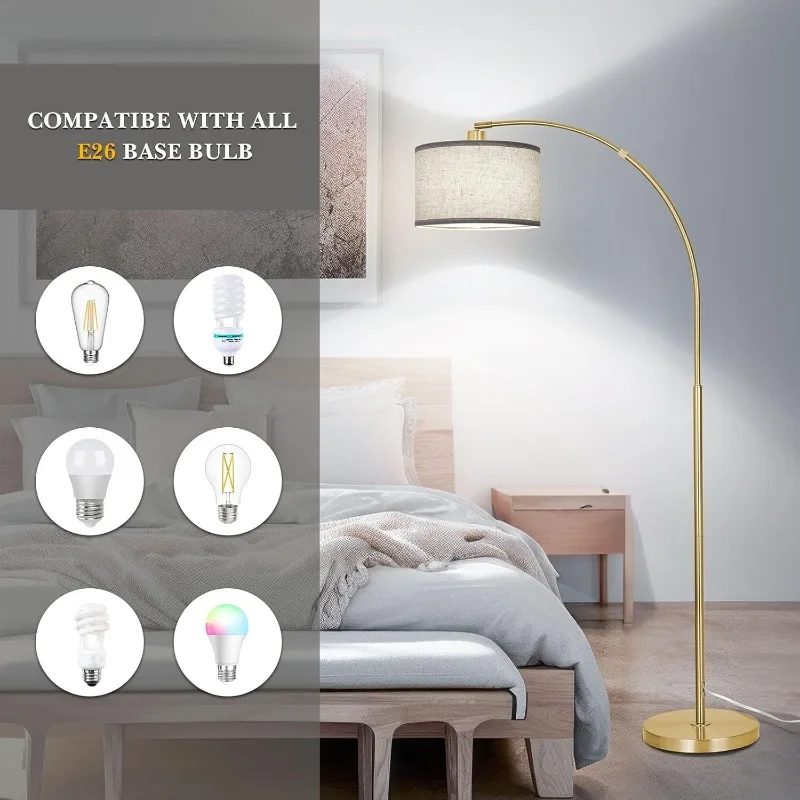
Creating Harmony: When to Match Wood Tones
Creating harmony through matching or closely coordinating wood tones creates a sense of intentional cohesion throughout your space.
Matching your arc lamp’s wood tone to existing furniture works particularly well when:
* You want to create a serene, cohesive aesthetic
* Your space already contains several different wood pieces
* The room serves restful purposes (bedrooms, reading nooks)
* You’re working with formal or traditional design styles
The benefits of this approach include visual flow that feels seamless and sophisticated, reduced visual clutter, and an enhanced sense of thoughtful curation. The result feels polished and intentionally designed.
To avoid monotony when matching woods, incorporate variation through other elements:
* Mix different wood textures (smooth with rough)
* Vary the sheen levels (matte with glossy)
* Incorporate contrast through non-wood elements
* Focus on subtle variations within the same tone family
When identifying matching tones, don’t aim for perfect identity—look for woods that share the same underlying tone family and depth, even if the species differs. For instance, a medium walnut lamp can coordinate beautifully with medium cherry furniture if their depth and undertones are compatible.
Retro arc lamps with wood elements often feature distinctive tones that can be matched with vintage or contemporary pieces for a cohesive look that spans different eras.
Creating Contrast: Dynamic Wood Tone Pairings
Alternatively, using contrasting wood tones creates visual energy and interest through intentional difference.
Contrasting your arc lamp’s wood tone with existing furniture works particularly well when:
* You want to create visual excitement and energy
* Your room feels too matched or monotonous
* The lamp should function as a focal point or statement piece
* You’re working with eclectic, contemporary, or creative design styles
The benefits include added visual depth, increased design interest, and creation of natural focal points. Spaces with thoughtful contrast often feel more curated and intentionally designed than completely matched rooms.
For successful contrasting:
* Maintain consistency in undertones (all warm or all cool woods)
* Create clear difference in lightness/darkness (don’t use woods that are only slightly different)
* Use the lightest and darkest tones purposefully to draw attention where desired
* Consider the lamp’s position relative to other wood elements for maximum impact
Successful contrast doesn’t mean complete disconnection—find elements that tie different woods together, such as similar grain patterns, shared undertones, or complementary design eras.
The “Rule of Three” for Expert Wood Tone Mixing
Professional designers often employ the “Rule of Three” when mixing wood tones—using at least three different wood tones to create an intentional, collected-over-time appearance.
This approach works because:
* It clearly signals intentional design rather than unsuccessful matching
* It creates visual depth through varied layers
* It allows for greater flexibility in adding new pieces over time
* It mimics how we naturally collect furniture throughout our lives
To apply this principle with an arc floor lamp:
1. Identify the dominant wood tone in your space (usually the largest pieces like flooring or main furniture)
2. Select a secondary tone that’s already present (perhaps in accent furniture or trim)
3. Choose your arc lamp in a third complementary tone that has some relationship to the others
This approach works beautifully in most spaces, though very small rooms might become visually cluttered with too many wood variations. In compact spaces, consider limiting to two well-chosen wood tones instead.
Beyond Wood Tone: Complementary Design Elements
While wood tone is crucial, an arc lamp’s overall design impact comes from how all its elements work together. The wood base interacts with metal accents, shade design, and overall proportions to create a complete design statement.
Consider your arc lamp as a composition of complementary materials—each contributing to its overall aesthetic and functional success. The most striking designs often feature thoughtful tension between different materials, with each enhancing the others’ best qualities.
Professional designers recommend selecting a primary feature to emphasize—either the wood base, the metal elements, or the shade design—and letting the other elements play supporting roles. This creates visual hierarchy and prevents design elements from competing for attention.
Metal Accents: Enhancing Wood’s Natural Beauty
The metal components of an arc floor lamp significantly influence how we perceive its wood elements. The right metal-wood pairing enhances both materials, while poor combinations can create visual discord.
Ideal metal pairings for different wood tones:
* Light woods pair beautifully with: chrome, nickel, silver, black matte metals
* Medium woods harmonize with: brass, bronze, copper, brushed nickel
* Dark woods complement: gold, polished brass, bronze, black metals
* Specialty finishes work well with: blackened metals, mixed metals, copper
The lamp’s metal finish should ideally relate to other metal elements in your room, though perfect matching isn’t necessary. Consider establishing a primary and secondary metal finish throughout your space for cohesive variety.
The stable base designs for arc floor lamps often incorporate both wood and metal elements, creating opportunities for beautiful material contrast even within the lamp itself.
Shade Design: Balancing Form and Function
The shade material, opacity, and design dramatically affect how a wood-toned arc lamp integrates into your space.
Shade characteristics to consider:
* Material (fabric, metal, glass) impacts light diffusion and style formality
* Color affects how the wood tone is perceived (white/light shades emphasize the wood, colored shades create relationship with the wood)
* Opacity determines how much ambient versus directed light the lamp provides
* Size and shape influence the lamp’s visual weight and style classification
Light temperature significantly impacts wood tone perception:
* Warm light (2700-3000K) enhances red/yellow undertones in wood
* Natural/neutral light (3500-4000K) provides the most accurate wood color rendering
* Cool light (5000K+) emphasizes blue/gray undertones and can make warm woods appear duller
For maximum wood appreciation, select shades that direct some light downward onto the wood base itself, highlighting its grain pattern and natural beauty.
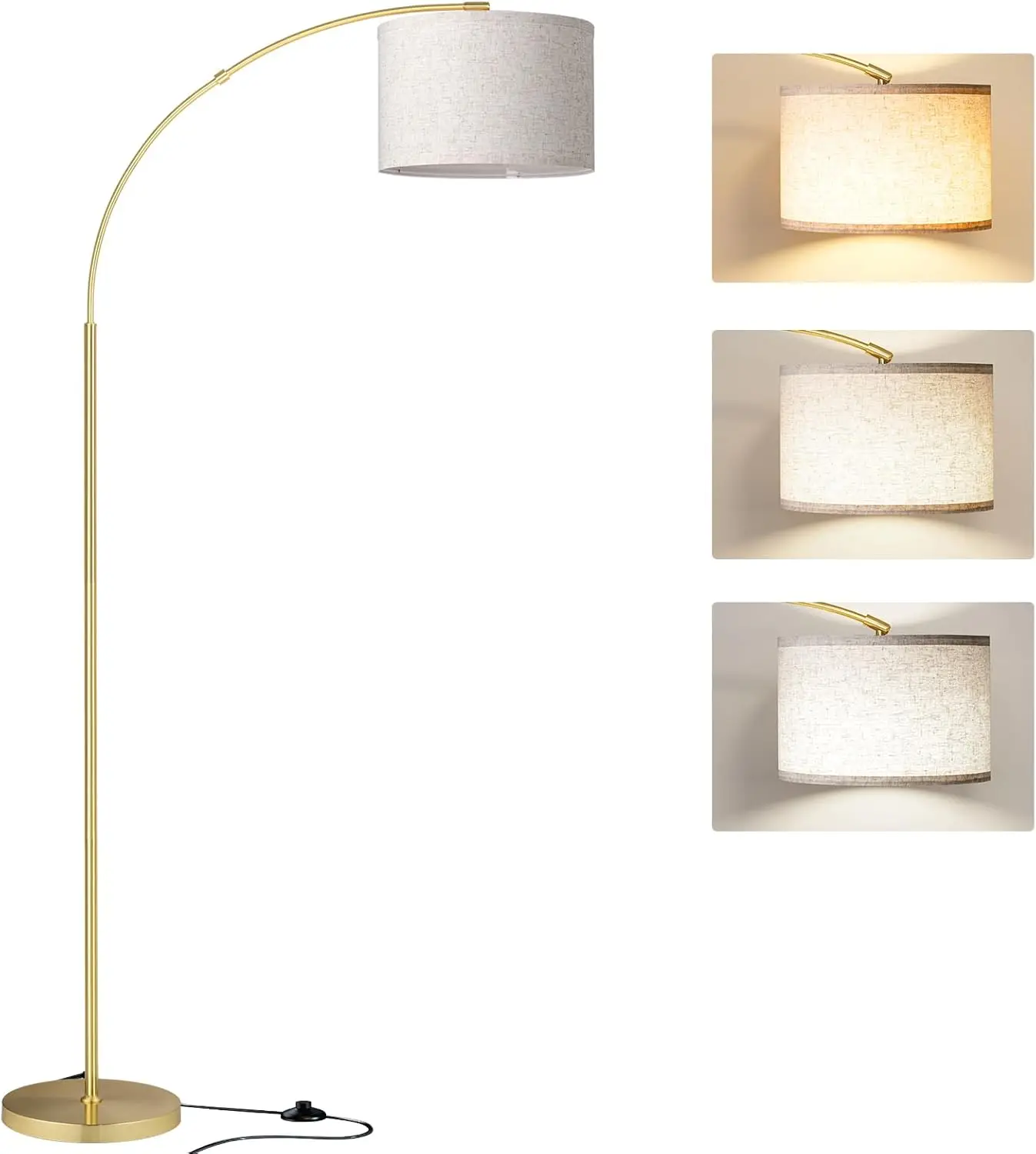
Scale and Proportion: Finding the Perfect Balance
The size and scale of your arc floor lamp significantly impact how its wood tone relates to your space.
For proper scaling:
* Consider ceiling height—taller ceilings can accommodate larger, more dramatic arcs
* Ensure the lamp’s reach is appropriate for the furniture it will illuminate
* Remember that darker woods appear visually heavier than lighter woods
* Allow adequate space around the lamp for its form to be appreciated
As a general guideline, larger rooms (over 300 sq ft) can handle substantial wood elements in darker tones, while smaller spaces often benefit from lighter woods that don’t overwhelm the visual field.
The arc’s curve and scale should relate proportionally to both the base size and the room dimensions. A perfectly proportioned lamp appears neither top-heavy nor insubstantial, regardless of its wood tone.
Curated Recommendations: Matching Woods to Spaces
Finding the perfect wood tone becomes easier when you understand how different options complement specific design styles. Here are tailored recommendations for popular interior aesthetics:
For Scandinavian/Nordic Spaces:
* Ideal wood tones: Very light oak, ash, or bleached woods
* Complementary elements: Minimal metal accents in brushed silver or black
* Shade recommendation: White, light gray, or natural linen in simple shapes
* Special consideration: Choose woods with minimal grain pattern for authentic Nordic feel
For Mid-Century Modern Spaces:
* Ideal wood tones: Warm walnut, teak, or medium-toned woods
* Complementary elements: Brass or bronze metals with minimal ornamentation
* Shade recommendation: Drum or cone shapes in textural fabrics or vibrant colors
* Special consideration: Look for tapered legs and authentic mid-century proportions
For Industrial/Urban Spaces:
* Ideal wood tones: Distressed woods, reclaimed timber, or dark stains
* Complementary elements: Black iron, steel, or weathered metals
* Shade recommendation: Metal shades or exposed bulb designs
* Special consideration: Woods with visible character, knots, and history work best
For Traditional/Classic Spaces:
* Ideal wood tones: Cherry, mahogany, or medium-to-dark stained woods
* Complementary elements: Antique brass or bronze with some detailing
* Shade recommendation: Fabric shades with pleating or texture in neutral tones
* Special consideration: Choose woods with visible fine grain and rich coloration
For Contemporary Minimalist Spaces:
* Ideal wood tones: Either very light (ash, white oak) or very dark (wenge, ebony)
* Complementary elements: Chrome, polished nickel, or matte black metals
* Shade recommendation: Simple geometric forms in white, black, or neutral colors
* Special consideration: Look for clean lines and minimal visible grain for modern appeal
Mid-Century Arc Floor Lamp, Wood Arc Floor Lamp
$230.86 Select options This product has multiple variants. The options may be chosen on the product pageVintage Arc Floor Lamp, Wood Arc Floor Lamp
Price range: $603.87 through $1,346.09 Select options This product has multiple variants. The options may be chosen on the product pageLED Arc Floor Lamp, Retro Arc Lamp
$1,175.07 Select options This product has multiple variants. The options may be chosen on the product pageMinimalist Arc Floor Lamp, Wood Arc Floor Lamp
Price range: $366.32 through $1,008.61 Select options This product has multiple variants. The options may be chosen on the product page- Price range: $224.94 through $575.31 Select options This product has multiple variants. The options may be chosen on the product page
Black Arc Floor Lamp, Mid-Century Arc Floor Lamp, Rattan Arc Floor Lamp, Wood Arc Floor Lamp
$963.46 Select options This product has multiple variants. The options may be chosen on the product page
When selecting the ideal arc floor lamp for your space, consider both the room’s overall design direction and any existing wood elements that your new lamp should complement or intentionally contrast.
Maintaining Your Wood-Toned Arc Lamp
Proper care ensures your wood-toned arc lamp maintains its beauty for years to come.
General care guidelines:
* Dust regularly with a soft microfiber cloth to prevent buildup that can dull the finish
* Keep wood bases away from direct sunlight which can cause uneven fading
* Maintain consistent indoor humidity levels to prevent wood from cracking or warping
* Clean with products specifically formulated for finished wood surfaces
For different wood finishes:
* Natural oiled woods: Re-oil occasionally with appropriate wood oil
* Lacquered/sealed woods: Use only mild cleansers without alcohol or ammonia
* Painted woods: Avoid abrasive cleaners that might damage the paint layer
* Distressed/specialty finishes: Consult manufacturer guidelines for specific care
Environmental factors significantly impact wood longevity. Position your lamp away from heating vents, air conditioners, and extremely sunny windows that might cause wood to dry out or fade unevenly. Use felt pads under bases to protect both the wood and your floor surfaces.
For persistent smudges or fingerprints, lightly dampen a soft cloth with water, wring thoroughly, and gently wipe the wood surface, followed immediately by drying with a clean cloth. For stubborn spots, consult the manufacturer before using any specialized products.
FAQ: Common Questions About Wood Tone Selection
Is it acceptable to mix different wood tones in one room?
Absolutely! In fact, intentionally mixing wood tones creates visual interest and depth. The key is to ensure there’s some connecting element—similar undertones, complementary grain patterns, or bridging pieces that help create harmony among the different woods.
What’s the most versatile wood tone for an arc floor lamp?
Medium-toned woods like natural walnut and oak offer the greatest versatility. They work well with both lighter and darker woods and can easily transition between different design styles as your tastes evolve.
Should my lamp’s wood match my flooring exactly?
No, exact matching often looks forced. Instead, aim for complementary tones—if your floors are very dark, a mid-tone or light lamp creates appealing contrast. If your floors are light, you have flexibility to go either darker for contrast or similar for cohesion.
How do I determine the undertone of my existing furniture?
Place a pure white sheet of paper against the wood in natural light. This helps reveal whether the wood has warm undertones (reddish, yellowish, orange) or cool undertones (ashy, grayish). Identifying these undertones helps ensure new wood pieces will harmonize with existing ones.
Can wood tones affect the mood of a room?
Definitely! Lighter woods tend to create airy, casual, and relaxed environments, while darker woods typically create more formal, sophisticated, and intimate spaces. Your choice of wood tone significantly influences the emotional response to your room.
What wood tones work best in small spaces?
Generally, lighter to medium wood tones work better in smaller spaces as they reflect more light and appear less visually heavy. However, a dark wood lamp can create a beautiful focal point in a small room if other elements are kept light and streamlined.
How important is it to match the wood tone of my arc lamp to other lighting fixtures?
While coordination is important for visual cohesion, exact matching between all lighting fixtures isn’t necessary. Instead, consider your lighting fixtures as a family of related elements that share some common characteristics while maintaining their individual identity.

